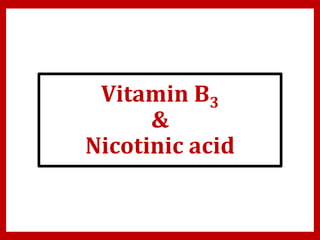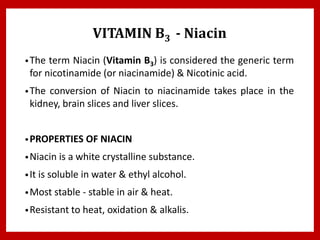Vitamin B 3 and Nicotinic acid
- 2. VITAMIN B3 - Niacin •The term Niacin (Vitamin B3) is considered the generic term for nicotinamide (or niacinamide) & Nicotinic acid. •The conversion of Niacin to niacinamide takes place in the kidney, brain slices and liver slices. •PROPERTIES OF NIACIN •Niacin is a white crystalline substance. •It is soluble in water & ethyl alcohol. •Most stable - stable in air & heat. •Resistant to heat, oxidation & alkalis.
- 3. STRUCTURE •Niacin (C6H5O2N) is simplest of all the known vitamins. It is pyridine derivative. It has a carboxyl group (COOH) at the 3- position. •In nicotinamide, the carboxyl group is replaced by a carboxamide (CONH2).
- 4. CHEMISTRY •Precursor : Dietary tryptophan •Dietary tryptophan contribute to the synthesis of the coenzymes Niacin (NAD⁺ and NADP⁺). •60 mgs tryptophan = 1 mg of niacin.
- 5. •Biosynthesis: The conversion of tryptophan to nicotinic acid in the body takes place through a series of intermediate steps, which are represented below:
- 8. BIOCHEMICAL FUNCTIONS •The coenzymes NAD⁺ and NADP⁺ are involved in a variety of “oxidation-reduction reactions”. •A large number of enzymes belonging to the class “oxidoreductase” are dependent on NAD⁺ or NADP⁺. •NAD⁺ and NADP⁺ participate in almost all the metabolisms (carbohydrate, lipid, protein etc). •Involved in electron transport chain to generate ATP.










